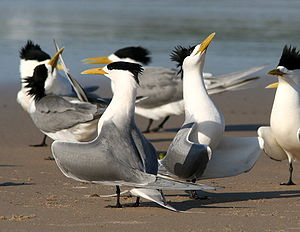- Courtship display
-
 Crested Tern, Thalasseus bergii (Syn. Sterna bergii), courtship display.
Crested Tern, Thalasseus bergii (Syn. Sterna bergii), courtship display.
Courtship display is a special, sometimes ritualised, set of behaviours which some animals perform as part of courtship. Courtship behaviours can include special calls, postures, and movements, and may involve special plumage, bright colours or other ornamentation. A good example is the 'dancing' done by male birds of paradise. Such behaviour has multiple purposes, but the first and foremost is to identify the species of the animal performing the display, and hence to prevent biologically wasteful matings between different species. For example, each of the British tit species displays a characteristic that distinguishes them from the others: the great tit swells its chest to show off its black stripe, the crested tit raises its crest, the bearded tit puffs out its black cheeks[1].Contents
Male display
As well as identifying the species of the displayer and their willingness to mate, the courtship displays of male animals often include other purposes. An obvious one is to impress the female with the male's vigour and biological fitness, and to persuade her to pick him above all other males – a form of sexual selection. The display may also have the added benefit of deterring rival males.
Female display
In species where the females compete with each other to claim males for mating (e.g. polyandrous species such as the phalarope), the females may show courtship display behaviours directed at attracting males.
Mutual display
Where male and female pair up for the breeding season, or longer, the pair-bond between the two is reinforced by doing a mutual display. Such a display often consists of synchronous actions like calling and head bobbing, or one partner repeating the motion of the other. Birds are especially well known for this type of behaviour: albatrosses, penguins and grebes are three such examples.
See also
References
External links
This ethology article is a stub. You can help Wikipedia by expanding it.
